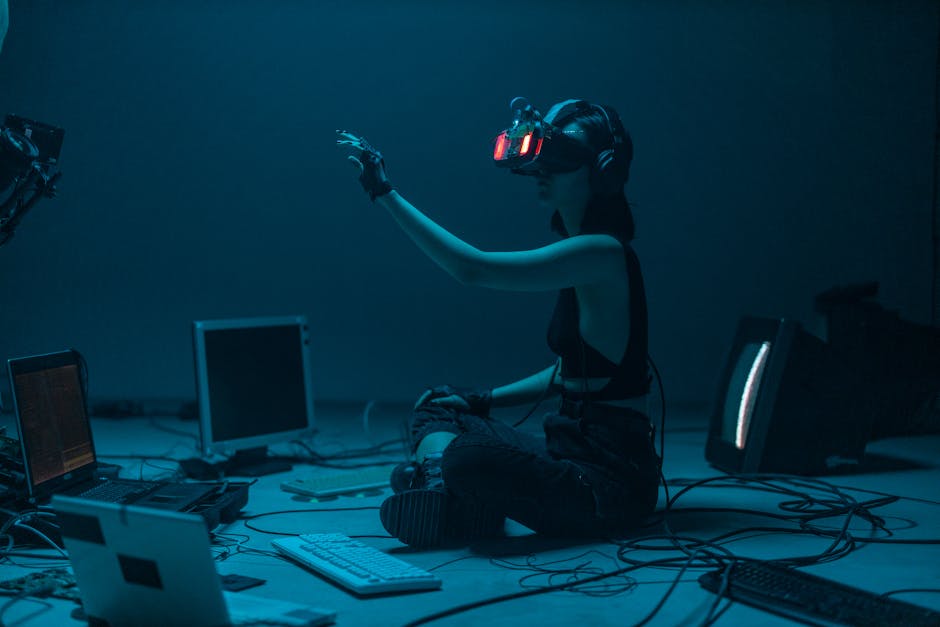Unraveling Virtual Reality: Discover Non-Linear Gameplay Secrets
Imagine stepping into a world where you make the rules. Virtual reality (VR) is transforming how players engage with games, particularly in open-world environments that emphasize non-linear gameplay. Gone are the days when players merely followed a predefined path; instead, they experience unparalleled freedom and agency. In this article, we’ll delve into the fascinating landscape of VR and the art of non-linear gameplay, focusing on how player freedom can redefine gaming narratives and experiences.
The Dawn of Virtual Reality in Gaming

Virtual reality is no longer a distant fantasy. With advancements in technology and greater accessibility, VR has become a cornerstone of modern gaming culture. Driven by immersive experiences, VR allows players to inhabit expansive worlds in ways traditional gaming cannot match. According to a report by the International Data Corporation (IDC), the global VR gaming market is expected to exceed $12 billion by 2025, demonstrating just how significant this medium is becoming.
As technology ceaselessly evolves, developers are tapping into the innate human desire for exploration and agency, crafting experiences that resonate deeply with diverse audiences. But how does this desire translate into non-linear gameplay?
Understanding Non-Linear Gameplay

Non-linear gameplay enables players to dictate the flow of their gaming experience. Contrasting with linear narratives, where players follow a set sequence of events, non-linear gameplay provides multiple pathways, encouraging exploration and interaction in an unpredictable environment. Games like "The Legend of Zelda: Breath of the Wild" exemplify this approach, empowering players to tackle challenges at their own pace and choosing their adventure's path.
In virtual reality, where immersion is paramount, non-linear gameplay shines. It doesn’t merely enhance gameplay but fundamentally alters the player's relationship with the game world, giving them the power to shape their journey.
Player Freedom and Agency

Player freedom and agency are at the heart of non-linear gameplay. Unlike traditional games, where progression often dictates experiences, VR games allow players to stray from paths and create their narratives. The level of immersion afforded by VR enhances this sense of agency, making every choice feel meaningful.
Take for example the game "Half-Life: Alyx." In this VR title, players engage with the environment by manipulating objects, solving puzzles, and making decisions that impact their gameplay. Players can explore areas at their leisure, turning what could be a linear progression into a personalized adventure.
Exploring Emergent Storytelling

Emergent storytelling is a key element of non-linear gameplay and one that truly shines in VR. This concept refers to narratives that arise organically through player interactions rather than being strictly scripted. Players can influence the plot by engaging with NPCs (non-player characters), discovering hidden lore, or even causing chain reactions through their choices.
In titles like "Red Dead Redemption 2," players can engage in side quests and random encounters that contribute unique storylines, ultimately shaping their adventures while diving into the rich tapestry of the game. This approach grants players agency and fosters a greater emotional investment in the narrative, enhancing their overall experience.
The Impact of Choice on Engagement

When players have the power to make significant choices, it fosters a deeper emotional connection to the game. This connection is essential for creating memorable experiences, as players feel their decisions bear weight.
One outstanding example of this is the game "Detroit: Become Human." Players guide multiple characters through intricate story arcs, with choices affecting relationships and outcomes. The branching mechanics ensure that every player's experience is unique, emphasizing that their choices matter. This model is becoming increasingly relevant in VR, where physical engagement and interaction elevate the stakes of choice even further.
Case Studies: Innovative Applications in VR

1. The Walking Dead: Saints & Sinners

This game combines narrative depth with immersive gameplay, allowing players to choose their paths in a post-apocalyptic world filled with tension and moral dilemmas. From strategic combat engagements to the forging of interpersonal relationships, player agency drives exploration and survival.
2. Skyrim VR

As another great example, "Skyrim VR" proves the success of non-linear gameplay in an open-world VR setting. Players can traverse Tamriel, crafting their destinies through quests and character interactions. The freedom to explore every nook and cranny enriches the VR experience.
3. Boneworks

This physics-based VR game takes player freedom to another level with its mechanics and sandbox-style gameplay, encouraging creative problem-solving and exploration of the interactive environment. Players chart their unique paths, with gameplay often evolving based on their choices and actions.
Interactivity: The Essence of Open-World Experiences

Interactivity is crucial in bridging the gap between the player and the narrative. Non-linear gameplay relies on the ability of players to actively participate and influence the game world.
In traditional gaming settings, interactivity is often limited to button presses or predetermined responses. However, VR opens the door to richer interactions, from physically manipulating objects to voice-activated dialogue systems. This intensifies engagement, offering players an experience tailored to their preferences.
The Role of Artificial Intelligence
The application of artificial intelligence (AI) in VR gaming also contributes to player freedom and agency. NPCs powered by advanced AI can respond dynamically to player choices, creating an organic gaming environment. This not only makes gameplay richer but adds layers of complexity, making non-linear pathways feel genuinely alive.
For insight into how AI is revolutionizing the gaming landscape, check out our article on AI-driven storytelling in video games.
Social Dynamics in VR
The social dynamics present in VR gaming can also influence non-linear narratives and player agency. Multiplayer VR experiences, such as "VRChat," illustrate how social interactions can lead to emergent storytelling. Players can craft experiences together, building narratives that diverge from anything pre-scripted.
This collaborative approach merges play with the social aspects of gaming, facilitating experiences based on shared agency. Players can drive the encounter's direction, enhancing their emotional investment.
Educational and Therapeutic Implications
With the rise of non-linear gameplay in VR, there are significant implications for education and therapy. Educational tools utilizing VR can offer interactive learning experiences where students chart their paths through complex subjects, reinforcing knowledge retention and engagement.
In therapy, VR can simulate scenarios to help patients confront fears or rehearse social interactions, all while allowing them to take control of their experiences. This evolving landscape opens the doors for a multitude of applications driven by player agency.
If you want to explore the correlation between gaming and mental health further, check out our article on gamification of mental health.
Speculating About the Future
The future of VR and non-linear gameplay is immensely promising. As developers harness the power of technology and artificial intelligence, the landscapes of gaming and narratives will continue to evolve. We may see more adaptive storytelling based on real-time player feedback, driving deeper levels of engagement.
The convergence of various technological advancements, including haptic feedback, eye tracking, and neural interfaces, will guarantee more immersive experiences yet to come. Imagine a world where players feel pain or elation in tandem with their characters!
Furthermore, as VR hardware becomes increasingly affordable and accessible, we can anticipate a broader audience engaging with these non-linear experiences. The expanding creativity and innovation in the gaming industry can pave the way for uniquely enriching encounters crafted around human experiences and storytelling.
Final Thoughts
Virtual reality represents a pivotal shift in how we approach gaming. Non-linear gameplay not only enhances player freedom and agency but also nurtures richer narratives and experiences. As players step into these expansive worlds, they do not merely partake; they define their adventures, sparked by creativity and exploration.
As we look ahead, the future of non-linear gameplay promises innovation that can redefine storytelling while enriching our understanding of personal agency in game design. Embracing these experiences offers players not just a game, but the chance to explore a universe shaped by their choices. So, gear up and step into the extraordinary world of non-linear virtual reality gaming; who knows what stories await you?


